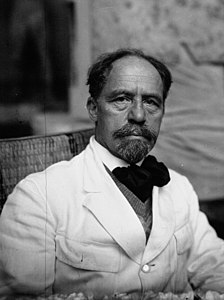You can help expand this article with text translated from the corresponding article in French. (July 2016) Click for important translation instructions.
|

Paul Maximilien Landowski (1 June 1875 – 31 March 1961) was a French monument sculptor of Polish descent. His best-known work is Christ the Redeemer in Rio de Janeiro, Brazil.
Biography
Landowski was born in Paris, France, of a Polish refugee father of the January Uprising, and a French mother Julie Vieuxtemps, daughter of Henri Vieuxtemps. He studied at the Académie Julian, before graduating from the École nationale supérieure des Beaux-Arts, he won the Prix de Rome in 1900 with his statue of David, and went on to a fifty-five-year career. He produced over thirty five monuments in the city of Paris and twelve more in the surrounding area. Among those is the Art Deco figure of St. Genevieve on the 1928 Pont de la Tournelle.
He also created Les Fantomes, the French Memorial to the Second Battle of the Marne which stands upon the Butte de Chalmont in Northern France, and the two major Monuments aux Morts in French North Africa, respectively known as Le Pavois in Algiers (hidden since 1978 in the Memorial to the Liberation of Algeria) and the monument à la victoire et à la paix in Casablanca (originally on today's Mohammed V Square, relocated to France in 1961 and re-erected in 1965 in Senlis).
Landowski is widely known for the 1931 Christ the Redeemer statue in Rio de Janeiro, Brazil, a collaboration with civil engineer Heitor da Silva Costa and architect and sculptor Gheorghe Leonida. Some sources indicate Landowski designed Christ's head and hands, but it was Leonida who created the head when asked by Landowski.
He won a gold medal at the art competitions at the 1928 Summer Olympics for Sculpture, an event held from 1912 to 1952. From 1933 through 1937 he was Director of the French Academy in Rome. He also served as an art–juror with Florence Meyer Blumenthal in awarding the Prix Blumenthal, a grant given between 1919–1954 to young French painters, sculptors, decorators, engravers, writers and musicians.
Landowski was the father of artists: painter Nadine Landowski (1908–1943), agricultural engineer and Legion d’Honneur, fallen in the Debarquement de Provence (Jean Maximilian Landowski) (1911-1944), composer Marcel Landowski (1915–1999), and pianist and painter Françoise Landowski-Caillet (1917–2007). He died in Boulogne-Billancourt, a suburb of Paris, where a museum dedicated to his work has over 100 works on display.
References
- Michèle Lefrançois. Paul Landowski: l'œuvre sculpté(fr)
- "Paul Landowski". Olympedia. Retrieved 24 July 2020.
- "Florence Meyer Blumenthal". Jewish Women's Archive, Michele Siegel.
External links
| Olympic medal record | ||
|---|---|---|
| Art competitions at the Summer Olympics | ||
| 1928 Amsterdam | Sculpture | |
- Official web site
- Paul Landowski Collection at Google Cultural Institute
- Paul Landowski in American public collections, on the French Sculpture Census website

- Paul Landowski at Masters of 20th Century Figure Sculpture
- 1875 births
- 1961 deaths
- Prix Blumenthal
- Christ the Redeemer (statue)
- Sculptors from Paris
- French architectural sculptors
- Prix de Rome for sculpture
- Olympic gold medalists in art competitions
- French people of Polish descent
- Members of the Académie des beaux-arts
- Burials at Passy Cemetery
- 20th-century French sculptors
- French male sculptors
- Medalists at the 1928 Summer Olympics
- Olympic competitors in art competitions